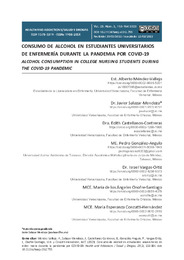Por favor, use este identificador para citar o enlazar este ítem:
https://hdl.handle.net/11000/29862Registro completo de metadatos
| Campo DC | Valor | Lengua/Idioma |
|---|---|---|
| dc.contributor.author | Méndez Vallejo, Alberto | - |
| dc.contributor.author | Salazar-Mendoza, Javier | - |
| dc.contributor.author | CASTELLANOS CONTRERAS, EDITH | - |
| dc.contributor.author | González-Angulo, Pedro | - |
| dc.contributor.author | Onofre Santiago, María de los Angeles | - |
| dc.contributor.author | Conzatti, María Esperanza | - |
| dc.contributor.author | ortiz vargas, israel | - |
| dc.contributor.other | Departamentos de la UMH::Psicología de la Salud | es_ES |
| dc.date.accessioned | 2023-10-30T10:06:19Z | - |
| dc.date.available | 2023-10-30T10:06:19Z | - |
| dc.date.created | 2023-07 | - |
| dc.identifier.citation | Revista Health and addictions/salud y drogas Vol.23, nº2(2023) | es_ES |
| dc.identifier.issn | 1988-205X | - |
| dc.identifier.issn | 1578-5319 | - |
| dc.identifier.uri | https://hdl.handle.net/11000/29862 | - |
| dc.description.abstract | Objetivo. Determinar el consumo de alcohol en estudiantes universitarios de enfermería durante la pandemia por COVID-19.Método. Investigación cuantitativa, descriptiva y transversal, en una muestra de 309 estudiantes de la Licenciatura en Enfermería, durante agosto 2021 a enero 2022, con muestreo intencional, aplicando la prueba AUDIT y en apego a los aspectos éticos de la Ley General de Salud en Materia de Investigación para la Salud de México. El análisis de datos se desarrolló con el uso de estadística descriptiva, frecuencia, porcentaje y prueba no paramétrica de Chi cuadrado. Resultados. El 25.6% son hombres y 74.4% mujeres, el 72.8% no presentó COVID-19 y 30.7% estuvo en cuarentena, el 70.9% se clasificó con un consumo ocasional, 17.5% son abstinentes, 11% con patrón de riesgo, per- judicial (0.3%) y dependencia alcohólica (0.3%). Conclusión. La mujer es quien más consume alcohol en frecuencia (73.9%) y los hombres en volumen aunque sea en menos ocasiones exponiéndose a mayores riesgos de salud como la dependencia de la sustancia. Durante la pandemia, las personas que confirmaron consumir alcohol, continuaron con el hábito de ingesta de manera normal, aun cuando fueron ellas, las que más enfermaron. El consumo de alcohol se presentó por situaciones secundarias como el encierro en casa, estrés, ansiedad y preocupación, por ello, es importante diseñar intervenciones de enfermería ante el fenómeno de drogas e implementarlas al regreso presencial de actividades para limitar el daño y evitar consecuencias en el desempeño académico | es_ES |
| dc.description.abstract | Objective. To determine alcohol consumption in undergraduate nursing students during the COVID-19 pandemic. Method.Quantitative, descriptive and cross-sectional research, in a sample of 309 students of theBachelor’s Degree in Nursing, during August 2021 to January 2022, with intentional sampling, applying the AUDITtest and in compliance with the ethical aspects of the General Health Law on Research for the Health of Mexico. Dataanalysis was developed using descriptive statistics, frequency, percentage and nonparametric Chi-square test.Results.25.6% are men and 74.4% women, 72.8% did not present COVID-19 and 30.7% were in quarantine, 70.9%were classified with occasional consumption, 17.5% are abstinent, 11% with risk pattern, harmful (0.3%) and alcoholdependence (0.3%). Conclusion. Women are the most frequent consumers of alcohol (73.9%) and men are the mostfrequent consumers of alcohol, al- though on fewer occasions, exposing themselves to greater health risks such as dependence on the substance. During the pandemic, the people who confirmed alcohol consumption continued with the habit of drinking alcohol in a normal way, even though they were the ones who got sick the most. Alcoholconsumption was presented by secondary situa- tions such as confinement at home, stress, anxiety and worry;therefore, it is important to design nursing interventions in the face of the drug phenomenon and implement themwhen returning to activities to limit the damage and avoid consequences on academic performance | es_ES |
| dc.format | application/pdf | es_ES |
| dc.format.extent | 12 | es_ES |
| dc.language.iso | spa | es_ES |
| dc.publisher | Universidad Miguel Hernández de Elche | es_ES |
| dc.rights | info:eu-repo/semantics/openAccess | es_ES |
| dc.rights.uri | http://creativecommons.org/licenses/by-nc-nd/4.0/ | * |
| dc.subject | Alcoholismo | es_ES |
| dc.subject | consumo de alcohol | es_ES |
| dc.subject | enfermería | es_ES |
| dc.subject | estudiantes universitarios | es_ES |
| dc.subject | pandemia por COVID-19 | es_ES |
| dc.subject | Alcoholism | es_ES |
| dc.subject | alcohol consumption | es_ES |
| dc.subject | nursing | es_ES |
| dc.subject | COVID-19 pandemic | es_ES |
| dc.subject.other | CDU::1 - Filosofía y psicología::159.9 - Psicología | es_ES |
| dc.title | Consumo de alcohol en estudiantes universitarios de enfermería durante la pandemia por covid-19 | es_ES |
| dc.title.alternative | Alcohol consumption in college nursing students duringthe covid-19 pandemic | es_ES |
| dc.type | info:eu-repo/semantics/article | es_ES |
| dc.relation.publisherversion | https://doi.org/10.21134/haaj.v23i2.755 | es_ES |

Ver/Abrir:
755-Texto del artículo-5254-1-10-20230727.pdf
430,22 kB
Adobe PDF
Compartir:
 La licencia se describe como: Atribución-NonComercial-NoDerivada 4.0 Internacional.
La licencia se describe como: Atribución-NonComercial-NoDerivada 4.0 Internacional.
.png)